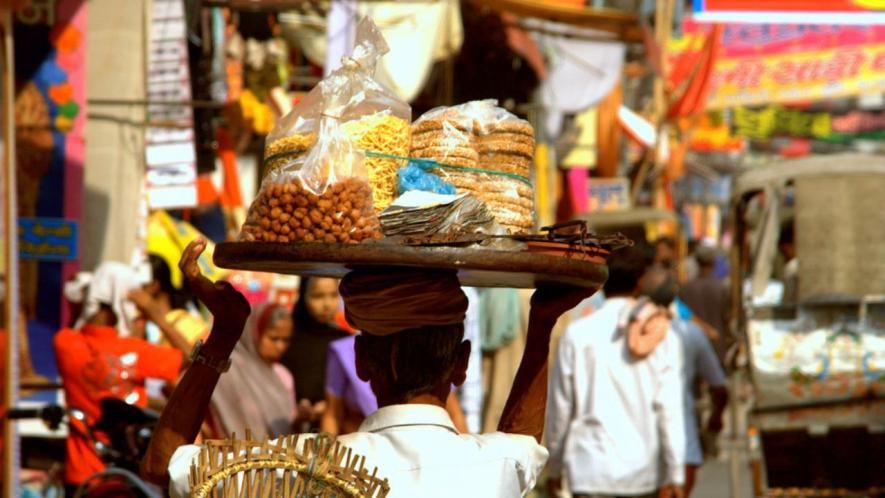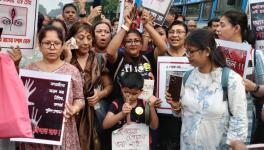Kolkata Hawkers: Politics of 'Illegality' and Urban Poor

Representational Image. Image Courtesy: Flickr
Indian cities have been trying to position themselves as world-class, where they have resorted to employing the rhetoric of ‘development’ to ensure that they look aesthetic, which practically translates to the removal of signs of backwardness and poverty. In many incidents, the term encroachers is employed against urban informal actors, such as beggars, squatters, and hawkers, who the State displaces, while the elite gets to capture public space by parking cars and extending their houses on footpaths without much rebuttal.
The neo-liberalisation of public spaces has led to an increase in the necessity of regulating the usage of public space, which was seen in the run-up to the G20 Summit in New Delhi when the law disproportionately impacted the underprivileged at the cost of beautifying the city. Every city has had a history of informal stores on the pavements, where hawkers have had to negotiate with the State to contest and claim spaces.
In Kolkata, hawkers constitute one of the most extensive and most organised sections within the informal economy and have faced the constant threat of being displaced while resisting it through the years. The crackdown on the hawkers has been led by the Kolkata Municipal Corporation, Kolkata Metropolitan Development Authority, and the Public Works Department out of fear of an influx of partition refugees from then East Pakistan.
Sociologist Amita Baviskar, through the conceptualisation of bourgeois environmentalism, argues how an upper-class sense of morality and aesthetics dominates public space discourse, which calls for removing the ‘ugliness’ of production from the sights and pushing outside the city.
Hawkers in Kolkata have always been considered as spoiling the aesthetic of the city, one that is constructed and rooted in an idea of colonial glory, and have thus been targeted through various concentrated efforts by successive ruling dispositions to remove them, even when some of these political parties while being in the opposition, opposed such measures themselves.
In late June, the West Bengal Chief Minister, Mamata Banerjee, addressed a meeting with bureaucrats, civic authorities, MLAs, and senior police officials, where she raised concerns about footpath ‘encroachments’ and extortion. She even held one of the MLAs, Sujit Bose, responsible for enabling hawkers in one of the localities in Kolkata. The next day, the authorities sprang into action, carrying out widespread eviction to remove hawking stalls across Kolkata and suburbs of the state. As the civic authorities and police surveyed the streets across the state to ‘identify’ the encroachment by hawkers, the latter were anxious about the losses they would face from being unable to conduct their business. After the eviction drive, some of the busiest areas in Kolkata, such as the New Market Area, known for street vendors selling various goods, wore a deserted look.
Hawking has been seen as a hindrance and obstruction in the “world-class” image which cities across the country have been pursuing for a while now, where academics and activists have spoken in favour of the vendors, highlighting how they are an integral part of the informal economy which adds to the country’s wealth. However, interestingly enough, the West Bengal Chief Minister stalled the eviction drive a few days later, stating that she had no right to take away anyone’s livelihood. Further, the police have identified 114 unauthorised parking spots in the city following the Chief Minister’s remark on fleecing the people in the name of parking, which has led to a drive against those running the spots, arresting parking tours and penalising owners of private vehicles.
While hawking has been portrayed as an obstruction for the middle class, as hawkers are seen as encroaching upon public space, the same amount of criticism is seldom levelled against private vehicles.
Hawking evolved as a means of survival for the marginalised, primarily taken up by those affected by economic crises and the large-scale migration induced by the Partition. While the social groups that would engage in hawking kept changing with time, as illustrated by historian Ritajyoti Bandopadhyay in Streets in Motion. The Making of Infrastructure, Property, and Political Culture in Twentieth-century Calcutta, the durability of hawking as a profession survived and was helpful to anyone who needed it.
Based on his fieldwork, Bandopadhyay argues that street hawking is not a credit-driven enterprise and estimated that their daily sales would be anywhere between ₹6,800 and ₹13,500, much higher than the minimum wage set by the government, which made it a viable venture for the marginalised with no avenue.
All efforts to evict and rehabilitate hawkers have failed time and again, as the locations which are usually chosen for resettlement do not provide a viable means of sustenance that the hawkers would find in their original spots, which were strategically chosen as they were usually close to markets, offices, or even universities. The strategic positioning of the hawkers would attract a large base of customers, who would often prefer purchasing from them over established stores due to the possibility of lower prices and more options.
Sukriti, a law student based in Kolkata, feels that hawkers are an integral part of the city as they work not to make abysmal profits but to sustain themselves and provide an affordable alternative to those who cannot afford to eat and shop from complexes.
“In places like Rabindra Sadan, there are students and office-goers who depend on the hawkers who sell food items for as low as ₹60 while established cafes and restaurants price their items around ₹300 at a minimum, which is not always filling. These eviction drivers and anti-hawker sentiments among the residents overlook that they are filling a gap which other players are not able to because not everyone can afford to spend upward of ₹500 each day for food,” she says.
“Hawking was there, hawking is there, and hawking will be there. Period,” says Rounak, an activist affiliated with the Jatiyo Bangla Sammelan (JaBaS), a sociopolitical force working for the rights of Bengali people, which also has hawker unions under its aegis.
“The uber-rich can argue all they want, but the fact of the matter is that in the absence of hawkers, the corporations will gain a monopoly which will be a matter of concern as hawkers are able to sell their purchases because there is a demand for them,” he says.
Rounak further elaborates on how the rail hawkers’ union under the JaBaS is in a rather sticky spot, given that the Street Vendor Act, 2014, which protects hawkers’ livelihood, does not include railway hawkers. In many instances, the Eastern Railway posts notices that hawkers in railway premises are provided with the option to vacate within eight days, failing which they are threatened with action being taken against them. Rounak believes that given the existence of the Street Vendor Act 2014, “no government body will be brazen enough to evict street hawkers, at least in West Bengal.” The JaBaS, he says, is demanding that hawkers working on railway premises be included in the Street Vendor Act so that their rights are protected as well.
Meanwhile, Bandopadhay feels that the eviction drive by the West Bengal government is “a planned spectacle and a balancing act by the Mamata Banerjee-led government in West Bengal so that she can provide a sense of assurance to the middle-classes that she has their interests at heart too.”
In the last decade, the new middle class, which has emerged due to economic reforms, has encouraged policies transforming metropolises into world-class cities.
Bandopadhyay argues that hawking, being a product of economic crises, harbours the capability to sustain economic crises during times when large corporations may fail. While the Chief Minister, according to him, may not “ideologically be pro-working class, but petit bourgeoise populist,” her rise to political power can be traced back to her offering to stand with the disenfranchised and the marginalised, which includes hawkers who form a part of the support she has.
The eviction drive in Kolkata, he further notes, “was stopped within a few days and unlike other cities, Mamata Banerjee questioned not just the subaltern encroachment by the marginalised but also the elite encroachment, where the Kolkata police was seen cracking down on illegal parking as well.”
Thus, the resilience of street hawkers in Kolkata, who have resisted eviction drives through ages by negotiations with the State, are a testament that they are here to stay. Further, the working class and even the middle class heavily depend on them, ensuring the demand for their products is consistently high.
As a rickshaw puller in his early 60s notes, he has been able to survive in the city on his meagre income only because of hawkers who provide him with nutritious food for as low as ₹40-₹50, without which he believes his income would be insufficient.
Bandyopadhyay says while the ones living in gated communities in Kolkata might call for the “cities to be cleaned up and put into order, the very working-class people who come to work in their homes depend on hawkers for their daily meals, as carrying food is not feasible since it could get spoilt during summers and some might find it more convenient to eat at a vendor than cook early in the mornings before the venture out for work during the day.”
Nabarun, a hawker selling Chinese food in Rabindra Sadan, believes the government cannot keep him and the other hawkers away. “How many of us will they ask to move? The party people and the police regularly extort money, and we are able to pay because people are buying from my and other stores around here. You see, the other big stores here are not affordable for most people who go to college or work in offices nearby, and I am here for them. Of course, I earn a profit and sustain my family, but I also serve the people by making affordable food available to them.”
The hawkers are and shall remain an integral part of Kolkata and its economy; they have kept the city going without whom it may not last long, for unlike the large-scale corporations, they do not sell overpriced goods and are accessible to people from every facet of life.
Ankush Pal is a student of sociology at Jamia Millia Islamia, New Delhi. The views are personal.
Get the latest reports & analysis with people's perspective on Protests, movements & deep analytical videos, discussions of the current affairs in your Telegram app. Subscribe to NewsClick's Telegram channel & get Real-Time updates on stories, as they get published on our website.
























